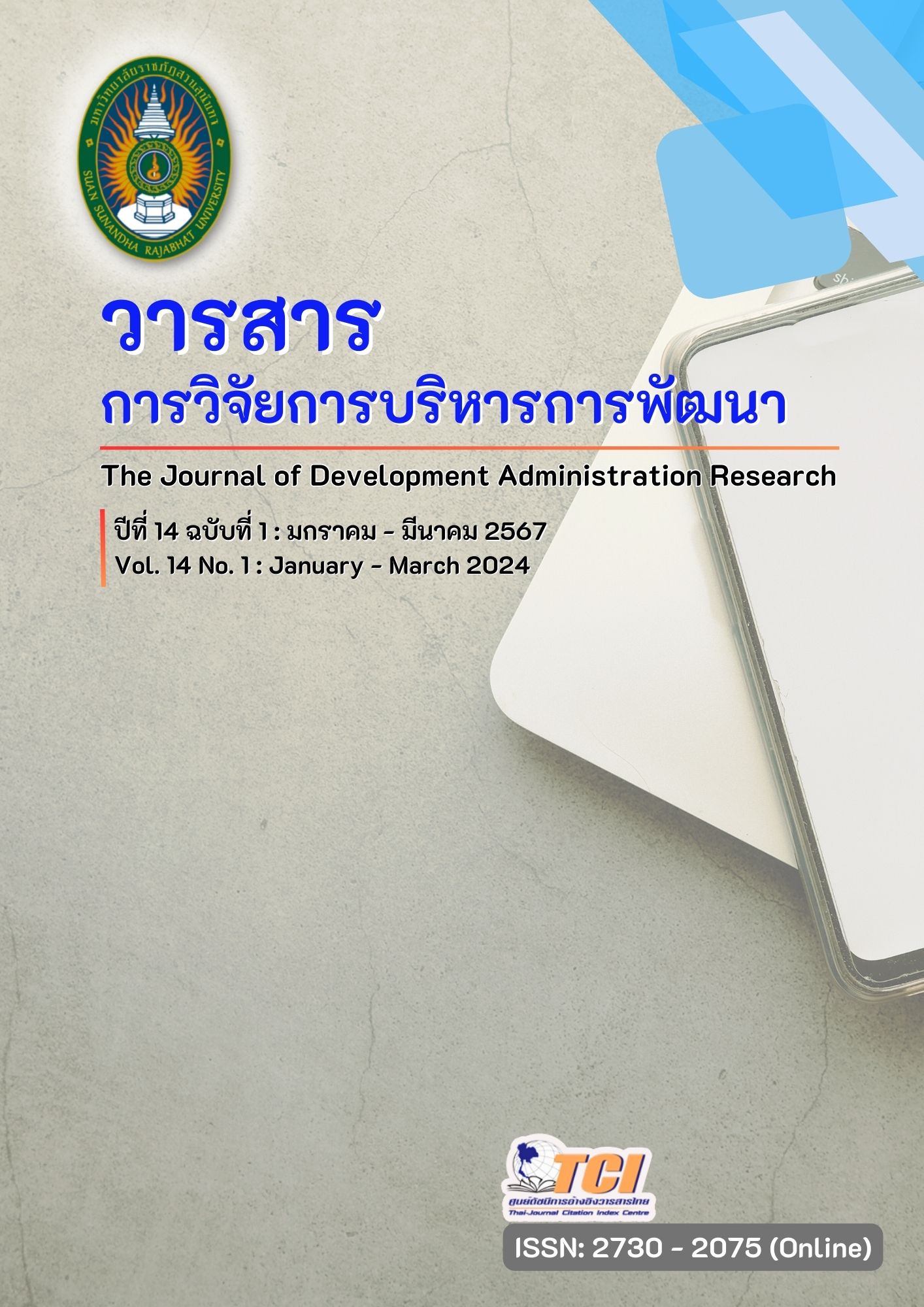ตัวแบบอิสลาโมโฟเบียในประเทศไทย
คำสำคัญ:
อิสลาโมโฟเบีย, การติดต่อระหว่างกลุ่ม, ความเคร่งศาสนา, ความรู้เกี่ยวกับอิสลาม, ภัยคุกคามระหว่างกลุ่มบทคัดย่อ
การศึกษาครั้งนี้มีวัตถุประสงค์เพื่อ 1) พัฒนาตัวแบบสมการโครงสร้างอิสลาโมโฟเบียในประเทศไทย และ 2) นำเสนอแนวทางการลดกระแสอิสลาโมโฟเบียในประเทศไทย โดยใช้กระบวนการวิจัยแบบผสมผสานเชิงอรรถาธิบาย และการวิจัยเชิงปริมาณ โดยรวบรวมข้อมูลจากกลุ่มตัวอย่างประชาชนชาวไทยพุทธจากพื้นที่ตึงเครียดจำนวน 510 ตัวอย่าง และวิเคราะห์ข้อมูลโดยใช้เทคนิคการวิเคราะห์โมเดลสมการโครงสร้าง การวิจัยเชิงคุณภาพ ทำการสัมภาษณ์เชิงลึกจากผู้มีส่วนได้ส่วนเสียในชุมชนจำนวน 15 คน ด้วยการเลือกตัวอย่างแบบเจาะจง และใช้การวิเคราะห์เนื้อหาในการวิเคราะห์ข้อมูล
ผลการวิเคราะห์ พบว่า 1) ปัจจัยที่มีความสัมพันธ์เชิงสาเหตุต่ออิสลาโมโฟเบียในประเทศไทย ตัวบ่งชี้มีน้ำหนักองค์ประกอบระหว่าง .50 ถึง .91 และทุกตัวแปรบ่งชี้มีนัยสำคัญทางสถิติที่ระดับ .001 แสดงว่าตัวบ่งชี้ทุกตัวเป็นตัวบ่งชี้ที่สำคัญของโมเดลอิสลาโมโฟเบียในประเทศไทย สมการโครงสร้างของตัวแบบปัจจัยเชิงสาเหตุที่พัฒนาขึ้นพบว่ามีความสอดคล้องกับข้อมูลเชิงประจักษ์ในระดับดีมาก (Chi-square = 35.732, CMIN/df = 1.261, df = 68, p-value = 0.072, GFI = 0.98, CFI = 0.998, NFI = 0.990, RMSEA = 0.023, TLI = 0.996) และ 2) การนำเสนอแนวทางการลดกระแสอิสลาโมโฟเบียในประเทศไทย ผู้วิจัยพบว่าผลการวิจัยสนับสนุนตามทฤษฎีที่ได้ทำการศึกษาอย่างชัดเจนว่าการลดกระแสอิสลาโมโฟเบียในประเทศไทย ควรให้น้ำหนักกับปัจจัยด้านการรับรู้ภัยคุกคามระหว่างกลุ่มมากที่สุด รองลงมาเป็นด้านความรู้เกี่ยวกับอิสลาม ด้านการติดต่อระหว่างกลุ่ม และด้านความเคร่งศาสนาพุทธ เนื่องจากมีอิทธิพลทางตรงและทางอ้อมต่ออิสลาโมโฟเบียในประเทศไทย ผลการวิจัยเชิงคุณภาพยังพบว่าปัจจัยสำคัญที่มีอิทธิพลต่อโรคกลัวอิสลามในประเทศไทยมีความสอดคล้องกับผลการวิจัยเชิงปริมาณในทุกประเด็น
เอกสารอ้างอิง
เอกรินทร์ ต่วนศิริ และ อันวาร์ กอมะ. (2562). ความสัมพันธ์ที่เปราะบางระหว่างชาวพุทธและมุสลิมในสังคมไทย.วารสารอิสลามศึกษา มหาวิทยาลัยสงขลานครินทร์, 10(2), 14-26.
Abrams, D., Van de Vyver, J., Houston, D. M., & Vasiljevic, M. (2017). Does terror defeat contact? Intergroup contact and prejudice toward Muslims before and after the London bombings. Peace and Conflict: Journal of Peace Psychology, 23(3), 260-268.
Allport, G. W. (1954). The Nature of Prejudice. Cambridge, MA: Addison-Wesley.
Allport, G. W., & Ross, J. M. (1967). Personal Religious Orientation and Prejudice. Journal of Personality and Social Psychology, 5, 432-443.
Alston, J. P. (1975). Three measures of current levels of religiosity. Journal for the Scientific Study of Religion, 14(2), 165-168.
Brambilla, M., Manzi, C., Regalia, C., & Verkuyten, M. (2013). Religiosity and prejudice: different patterns for two types of religious internalization. The Journal of Social Psychology, 153(4), 486-492.
Ciftci, S. (2012). Islamophobia and threat perceptions: Explaining anti-Muslim sentiment in the West. Journal of Muslim Minority Affairs, 32(3), 293-309.
Croucher, S. M., Galy-Badenas, F., & Ruotsalainen, M. (2014). Host culture acceptance, religiosity, and the threat of Muslim immigration: An integrated threat analysis in Spain. Journal of Intercultural Communication,35, 3.
Doger, G. K., & Ali, R. (2023, February 3). Islamophobia should be criminal offense, says Malaysian official. Retrieved April 27, 2023, from https://www.aa.com.tr
Dunn, K. M. (2004). Attitudes Towards Islam in Australia. Report for the Australia-Indonesia Institute. Geography Department, University of New South Wales.
Dunn, K. M. (2005). Australian public knowledge of Islam. Studia Islamika, 12(1), 1-32.
Dunn, K. M., Sharples, R., Diallo, T., Derbas, A., Vergani, M., McGarty, C., Elias, A. (2020). Understanding Victorains' Varied Attitudes Towards Muslims. Sydney: Western Sydney University.
Fugard, A. J. B., & Potts, H. W. W. (2015). Supporting thinking on sample sizes for thematic analyses: A quantitative tool. International Journal of Social Research Methodology: Theory & Practice, 18(6), 669–684.
González, K. V., Verkuyten, M., Weesie, J., & Poppe, E. (2008). Prejudice towards Muslims in the Netherlands: Testing integrated threat theory. British Journal of Social Psychology, 47(4), 667-685.
Gravelle, T. B. (2021). Explaining Islamophobia in Australia: Partisanship, intergroup contact, and local context. Australian Journal of Political Science, 56(2), 132-152.
Hair, J. F., Black, W. C., Babin, B. J., & Anderson, R. E. (2018). Multivariate Data Analysis (8thed.). Boston: Cencage.
Huber, S., & Yendell, A. (2019). Does religiosity matter?: explaining right-wing extremist attitudes and the vote for the Alternative for Germany (AfD). Religion and society in Central and Eastern Europe, 12(1), 63–82.
Islam, M. R., & Hewstone, M. (1993). Dimensions of contact as predictors of intergroup anxiety, perceived out-group variability, and out-group attitude: an integrative model. Personality and Social Psychology Bulletin, 19, 700-710.
Kanamori, Y. (2019). The effects of intergroup contact on intergroup anxiety and transgender prejudice: An examination using structural equation modeling (Order No. 13903076). ProQuest Dissertations & Theses Global. Retrieved from https://www.proquest.com/ dissertations-theses/effects-intergroup-contact-on-anxiety-transgender/docview/ 2308215328/se-2?accountid=28710
Kenny, P. (2021, March 4). Anti-Muslim hatred at 'epidemic' proportions: UN expert. Retrieved April 27, 2023, from https://www.aa.com.tr
Lee, S. A., Gibbons, J. A., Thompson, J. M., & Timani, H. S. (2009). The Islamophobia Scale: Instrument development and initial validation. International Journal for the Psychology of Religion, 19(2), 92-105.
Makashvili, A., Vardanashvilia, I., & Javakhishvilia, N. (2018). Testing intergroup threat theory: Realistic and symbolic threats, religiosity and gender as predictors of prejudice. Europe's Journal of Psychology, 14(2), 464–484.
Mansouri, F., & Vergani, M. (2018). Intercultural Contact, Knowledge of Islam, and Prejudice Against Muslims in Australia. International Journal of Intercultural Relations, 66, 85-94.
Munniksma, A., Stark, T. H., Verkuyten, M., Flache, A., & Veenstra, R. (2013). Extended intergroup friendships within social settings: The moderating role of initial outgroup attitudes. Group Processes & Intergroup Relations, 16(6), 752–770.
Novotný, J., & Polonský, F. (2011). The level of knowledge about Islam and perception of Islam among Czech and Slovak university students: Does ignorance determine subjective attitudes? Sociológia, 43(6), 674-696.
O’Donnell, K., Davis, R., & Ewart, J. (2017). Non-Muslim Australians’ knowledge of islam: Identifying and rectifying knowledge deficiencies. Journal of Muslim Minority Affairs, 37(1), 41-54.
O’Donnell, K., Ewart, J., & Alston-Knox, C. (2017). Baseline knowledge of Islam and Muslims: A study of Australian government crisis communication officials. Salus Journal, 5(2), 16-35.
Organisation of Islamic Cooperation. (2008). 1st OIC Observatory Report on Islamophobia.Saudi Arabia: The OIC Islamophobia Observatory.
Pettigrew, T. F., & Tropp, L. R. (2006). A Meta-analytic Test of Intergroup Contact Theory. Journal of Personality and Social Psychology, 90, 751–783.
Pettigrew, T. F., Tropp, L. R., Wagner, U., & Christ, O. (2011). Recent advances in intergroup contact theory. International Journal of Intercultural Relations, 35(3), 271-280.
Pickel, G., & Öztürk, C. (2018). Islamophobia without Muslims? The “Contact Hypothesis” as an explanation for anti-Muslim attitudes – Eastern European societies in a comparative perspective. Journal of Nationalism, Memory & Language Politics, 12(2), 163-191.
Runnymede Trust. (1997). Islamophobia: A Challenge for Us All. London: Runnymede Trust.
Stephan, W. G., Ybarra, O., & Morrison, K. R. (2009). Intergroup threat theory. In T. D. Nelson (Ed.), Handbook of prejudice, stereotyping, and discrimination (43-59). Mahwah, NJ: Lawrence Erlbaum.
Tahir, H., Kunst, J. R., & Sam, D. L. (2019). Threat, anti-Western hostility and violence among European Muslims: The mediating role of acculturation. International Journal of Intercultural Relations, 73, 74-88.
Tausch, N., Hewstone, M., & Roy, R. (2009). The relationships between contact, status and prejudice: An integrated threat theory analysis of Hindu-Muslim relations in India. Journal of Community & Applied Social Psychology, 19(2), 83-94.
Turner, R., Hewstone, M., Voci, A., & Vonofakou, C. (2008). A test of the extended intergroup contact hypothesis: the mediating role of intergroup anxiety, perceived ingroup and outgroup norms, and inclusion of the outgroup in the self. Journal of Personality and Social Psychology, 95(4), 843-860.
Uenal, F. (2016a). Disentangling Islamophobia: The differential effects of symbolic, realistic, and terroristic threat perceptions as mediators between social dominance orientation and Islamophobia. Journal of Social and Political Psychology, 4(1), 66–90.
Uenal, F. (2016b). The “Secret Islamization” of Europe: Exploring integrated threat theory for predicting Islamophobic conspiracy stereotypes. International Journal of Conflict and Violence, 9(1), 93-108.
Yendell, A., & Huber, S. (2020a). Negative views of Islam in Switzerland with special regard to religiosity as an explanatory factor. Journal for Religion, Society and Politics, 4, 81–103.
Yendell, A., & Huber, S. (2020b). The relevance of the centrality and content of religiosity for explaining Islamophobia in Switzerland. Religions, 11(3), 129.
ดาวน์โหลด
เผยแพร่แล้ว
รูปแบบการอ้างอิง
ฉบับ
ประเภทบทความ
สัญญาอนุญาต
ลิขสิทธิ์ (c) 2024 วารสารการวิจัยการบริหารการพัฒนา

อนุญาตภายใต้เงื่อนไข Creative Commons Attribution-NonCommercial-NoDerivatives 4.0 International License.
บทความที่ได้รับการตีพิมพ์เป็นลิขสิทธิ์ของมหาวิทยาลัยราชภัฏสวนสุนันทา
ข้อความที่ปรากฏในบทความแต่ละเรื่องในวารสารวิชาการเล่มนี้เป็นความคิดเห็นส่วนตัวของผู้เขียนแต่ละท่านไม่เกี่ยวข้องกับมหาวิทยาลัยราชภัฏสวนสุนันทา และคณาจารย์ท่านอื่นๆ ในมหาวิทยาลัยฯ แต่อย่างใด ความรับผิดชอบองค์ประกอบทั้งหมดของบทความแต่ละเรื่องเป็นของผู้เขียนแต่ละท่าน หากมีความผิดพลาดใดๆ ผู้เขียนแต่ละท่านจะรับผิดชอบบทความของตนเองแต่ผู้เดียว




